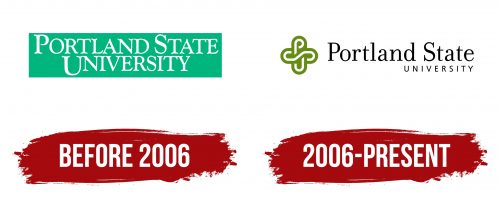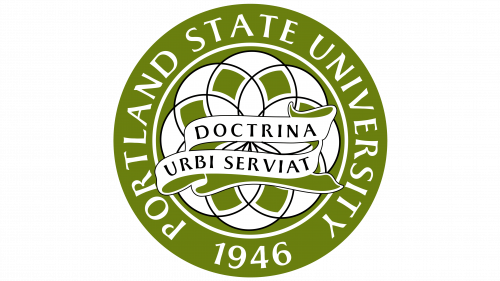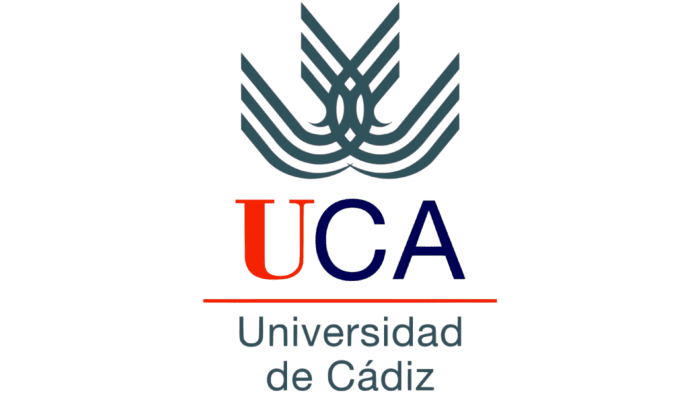 Portland State University Logo PNG
Portland State University Logo PNG
The Portland State University logo has traditionally been designed in a light green palette, the university’s primary color throughout history. The modern version of the logo maintains a commitment to this shade, complemented by black for the two text blocks and white for the background—this classic background has been used in all stages of the brand’s development.
The modern logo stands out for its simplicity and clarity. It is free from unnecessary details and contains no images, which gives it a unique and distinct style. Classic elements are harmoniously combined with current trends in identity design. The main advantage of such a concise logo is its informativeness. It is easily associated with Portland State University, an institution that has evolved from a small college for military veterans to a high-status research organization. The history of this institution dates back to 1946, when the Vanport Extension Center was founded, and it achieved university status in 1969.
This logo emphasizes the university’s stability and seriousness, preserving its traditions and commitment to growth. Thus, it is easily recognizable among other educational institutions.
Portland State University: Brand overview
Portland State University (PSU) began in 1946 with the establishment of the Vanport Extension Center. The center was in Vanport City, a temporary community built during the war for shipyard workers to help returning World War II veterans meet their higher education needs.
Initially, the Vanport Extension Center was run by the Oregon State System of Higher Education and offered only two-year programs. Despite its temporary status, it quickly gained popularity, enrolling over 1,500 students by 1947.
However, the center’s future changed dramatically on May 30, 1948, when a devastating flood destroyed Vanport City. Despite this disaster, the administration remained committed to its mission, and classes resumed in temporary facilities in downtown Portland just days after the flood.
In 1952, the name was changed to Portland State Extension Center to reflect its new location and growing role in Portland’s education system. That same year, it moved to the former Lincoln High School building in downtown Portland, establishing its first permanent campus.
A major milestone occurred in 1955 when the Oregon State Legislature authorized the center to grant bachelor’s degrees. With this decision, it became a four-year institution and was renamed Portland State College.
During the 1960s, the college experienced significant growth and development. New departments and programs, including a graduate school, were added, and the campus expanded with new buildings and facilities.
1969, the institution was granted university status and became Portland State University. This change reflected the growth and increasing importance within Oregon’s higher education system.
During the 1970s, the university continued to grow, expanding its academic offerings and research initiatives. In 1970, the School of Urban and Public Affairs (now the College of Urban and Public Affairs) was established, further cementing its connection to the urban community.
The 1980s saw significant campus expansion, including the construction of new buildings. The Branford P. Millar Library, which opened in 1975, underwent major renovations in the 1980s. During this time, the university developed programs to address urban issues, strengthening its ties to Portland’s communities.
The institution continued to evolve as an urban research university in the 1990s. The University Studies curriculum, introduced in 1995, became a model for general education at other colleges across the country—the program aimed to foster critical thinking and civic engagement in students.
The 2000s marked a period of rapid growth. Enrollment increased, and new departments and programs were created. In 2006, the institution launched its first doctoral program in social work. Several new research centers and institutes were also opened, enhancing research capabilities.
In 2008, the school launched “Building Our Future,” a major fundraising campaign to support student scholarships, improve campus facilities, and strengthen research.
Throughout the 2010s, the institution continued to grow and innovate. 2013, a sustainably designed building for the College of Urban and Public Affairs opened. In 2015, the “reTHINK PSU” initiative was launched, aimed at making higher education more accessible by introducing new approaches to learning.
In 2016, the university celebrated its 70th anniversary. From its beginnings as a small center for veterans, it had grown into Oregon’s largest university, offering a wide range of academic programs and a strong focus on research.
In 2017, a new initiative was introduced to strengthen community partnerships, enhance teaching and research, and improve student success.
The Viking Pavilion, a multi-purpose facility designed to enhance student life and foster a sense of community, opened in 2018.
In 2019, the institution’s research activities reached new heights with a record number of research grants, reinforcing its reputation as a top research institution.
Like many others, the university faced significant challenges in 2020 and 2021. However, it adapted by embracing new teaching and research methods and increasing its focus on online learning.
In 2022, a new initiative was launched to improve the quality of education, expand research activities, and strengthen ties to the Portland community.
By 2023, the institution had established itself as a leading urban research center known for its innovative programs, strong community partnerships, and commitment to sustainability. It continues to provide affordable, high-quality education while evolving to meet the needs of students and society.
Portland State Vikings are the athletic teams of Portland State University. They represent the university in various sports at the NCAA Division I level. The Vikings compete in the Big Sky Conference and are known for their football, basketball, and track and field performances.
From its beginnings as a small educational center for veterans, the university has grown into Oregon’s largest and most innovative institution. Throughout its history, it has remained committed to serving the metropolitan community and providing educational opportunities to all.
Meaning and History
What is Portland State University?
This public university in the heart of Oregon’s largest city offers a vibrant urban campus with a unique combination of academic excellence and practical experience. The university is known for its motto, “Let knowledge serve the city,” and actively integrates Portland’s progressive spirit into its academic programs. It takes pride in its community, which focuses on solving real-world problems, making it a hub of urban intellectual and creative activity. The university reflects Portland’s cultural and social diversity with a diverse student body and various disciplines, including technical fields and sustainability studies. The campus combines modern and historical architectural elements, creating a dynamic environment for learning and creativity.
Before 2006
Since the founding of the Vanport Extension Center, the institution’s seal has been introduced, and shortly after, the first logo appeared. This logo can be considered a symbol of Portland University, as it accurately and concisely reflects the educational institution’s focus.
The university’s name was written in large, bold letters on a green background, which later became an important part of the identity. The creators decided that the logo did not need additional images or symbols—it already clearly conveyed the essence of the educational institution. The same font was used for all the words, emphasizing the status of the organization, which at the time was still an educational center.
The three words were arranged in two rows: the phrase “Portland State” was on the first row, and “University” was on the second. The text was written in white, contrasting beautifully with the green rectangular background. Each word began with a capital letter, as required by spelling rules. All the characters had serifs and neat elements resembling hooks or arrows, giving the logo originality and elegance.
2006 – today
In 2006, the identity of Portland State University was updated, and the logo acquired unique elements that emphasized its individuality. The core meaning and content remained the same, but important details were added, giving the logo additional significance. Minimalism, as before, remained a key element, and each component was informative. On the left side of the logo, a graphic image of a cross appeared, executed in white and green tones. The university’s name was placed on the right in two rows, now looking more aesthetic and harmonious. The separation of the three words across different lines highlighted the university’s high status. The words “Portland State” were placed on the upper line, while “University” was moved to the right and written in a thin and elegant font.
The cross deserves special attention. This element draws the eye and reveals a hidden abbreviation of the university. Two letters are positioned along the vertical line, with the letter “S” centered on the cross, forming its horizontal axis. This design move adds depth and symbolism to the logo.
The Seal
The seal of Portland State University is one of the most original. It incorporates numerous informational elements, indicating that much time was devoted to its creation. The text, motto, beautiful shapes, and contours make the seal memorable and easily recognizable, simplifying the university’s identification.
As in the logo, green plays a key role in the seal, occupying a large part of its color palette. The seal consists of three significant parts. The central fragment draws the most attention. At the center is a geometric object resembling a flower with infinite petals. The petals are shaped like small diamonds, alternating between green and white colors. In the center are flowing white ribbons with the inscription “Doctrina Urbi Serviat,” which translates as “Let knowledge serve the city.” This motto can be seen as guidance or a prophecy.
A white circular contour visually separates the image from the next element. The university’s name is inscribed in large white letters around the circle, and at the bottom, the numerical value “1946” indicates the founding year of the Vanport Extension Center.






